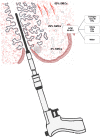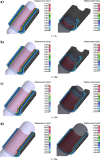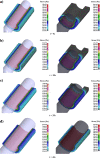Computer simulation of cervical tissue response to a hydraulic dilator device
- PMID: 24195810
- PMCID: PMC3831759
- DOI: 10.1186/1742-4682-10-64
Computer simulation of cervical tissue response to a hydraulic dilator device
Abstract
Background: Classical mechanical dilators for cervical dilation are associated with various complications, such as uterine perforation, cervical laceration, infections and intraperitoneal hemorrhage. A new medical device called continuous controllable balloon dilator (CCBD) was constructed to make a significant reduction in all of the side effects of traditional mechanical dilation.
Method: In this study we investigated numerically the cervical canal tissue response for Hegar and CCBD using our poroelastic finite element model and in-house software development. Boundary conditions for pressure loading on the tissue for both dilators in vivo were measured experimentally. Material properties of the cervical tissue were fitted with experimental in vivo data of pressure and fluid volume or balloon size.
Results: Obtained results for effective stresses inside the cervical tissue clearly showed higher stresses for Hegar dilator during dilation in comparison with our CCBD.
Conclusion: This study opens a new avenue for the implementation of CCBD device instead of mechanical dilators to prevent cervical injury during cervical dilation.
Figures






Similar articles
-
Continuous controllable balloon dilation: a novel approach for cervix dilation.Trials. 2012 Oct 22;13:196. doi: 10.1186/1745-6215-13-196. Trials. 2012. PMID: 23088906 Free PMC article. Clinical Trial.
-
Determination of the elastic properties of the cervix.Obstet Gynecol. 1988 Apr;71(4):568-74. Obstet Gynecol. 1988. PMID: 3353048
-
Analysis of cervical resistance during continuous controllable balloon dilatation: controlled clinical and experimental study.Trials. 2015 Oct 28;16:485. doi: 10.1186/s13063-015-1003-8. Trials. 2015. PMID: 26510412 Free PMC article. Clinical Trial.
-
Other mechanical methods for pre-induction cervical ripening.Semin Perinatol. 2015 Oct;39(6):444-9. doi: 10.1053/j.semperi.2015.07.006. Epub 2015 Sep 2. Semin Perinatol. 2015. PMID: 26341067 Review.
-
Adjunctive Agents for Cervical Preparation in Second Trimester Surgical Abortion.Adv Ther. 2019 Jun;36(6):1246-1251. doi: 10.1007/s12325-019-00953-2. Epub 2019 Apr 19. Adv Ther. 2019. PMID: 31004327 Free PMC article. Review.
References
-
- Fox MC, Hayes JL. Cervical preparation for second-trimester surgical abortion prior to 20 weeks of gestation. Contraception. 2007;76:486–495. - PubMed
-
- Kloeck FK, Jung H. In vitro release of prostaglandins from the human myometrium under the influence of stretching. Am J Obstet Gynecol. 1973;115:1066–1069. - PubMed
-
- Hulka JF, Lefler HT Jr, Anglone A, Lachenbruch PA. A new electronic force monitor to measure factors influencing cervical dilation for vacuum curettage. Am J Obstet Gynecol. 1974;120:166–173. - PubMed
-
- Fiala C, Gemzell-Danielsson K, Tang OS, von Hertzen H. Cervical priming with misoprostol prior to transcervical procedures. Int J Gynaecol Obstet. 2007;99:168–171. - PubMed
Publication types
MeSH terms
LinkOut - more resources
Full Text Sources
Other Literature Sources

